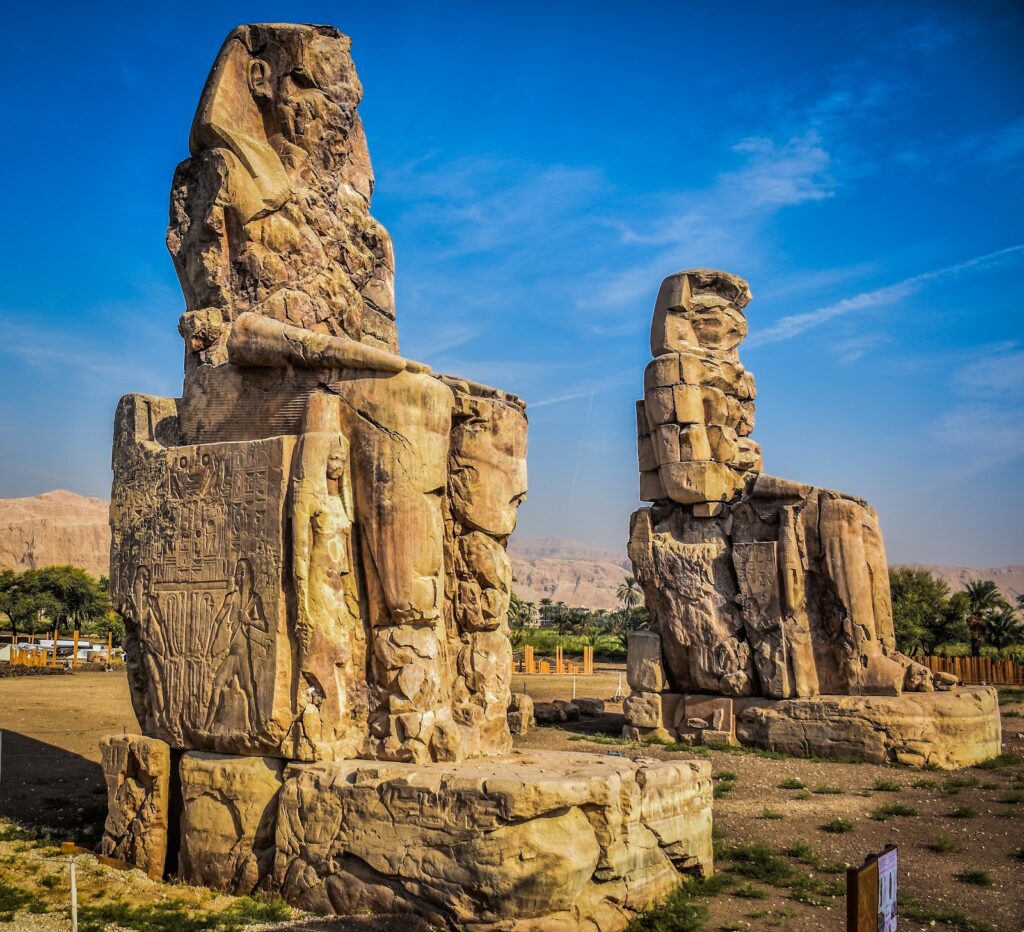The Grateful Statue: A Story of Art, Emotion, and Legacy2025
Introduction – The Timeless Power of Ancient Art
Emotion and Symbolism in Sculptural Form
Why This Statue Still Inspires Visitors Today
My Statue is Grateful

Remains of the mortuary temple of King Amenhotep III, undoubtedly one of the most magnificent and largest mortuary temples ever built. Evidence of this can be seen in the two giant statues of King Amenhotep III. It seems that the temple was destroyed by later kings, and all that remains are parts of the temple’s foundations and a mortuary stele.
The statue
The statue is large, about 10 meters long, and two massive statues called “My Statue” once adorned the front facade of the temple before the main building. The name Memnon given to it during the Greek period, attributed to the Trojan hero, son of Eros.
The two statues depict King Amenhotep III and are about 21 meters tall. They were carved from a single block of stone. The northern statue broke during a strong earthquake in 27 BC and, together with the wind, produced a sound resembling a high-pitched tone. This became known as the “Song of Memnon.” The Roman Emperor Hadrian and his wife traveled to see and hear this marvel. During the era of Emperor Septimius Severus, the cracks in this statue were filled with materials, and it no longer sang.
The Story Behind the Grateful Statue
Historical Background and Cultural Significance
Myths, Legends, and Local Interpretations
The Colossi of Memnon
The Colossi of Memnon stand as eternal sentinels on the west bank of the Nile near Luxor, echoing the grandeur of ancient Thebes. These two massive statues, each rising over 18 meters high, once flanked the entrance of the grand mortuary temple of Pharaoh Amenhotep III. Carved from quartzite sandstone, the statues depict the seated pharaoh, hands resting on his knees, facing east toward the rising sun. Though the temple behind them has largely disappeared over the millennia—due to floods, earthquakes, and the repurposing of its stone—the legacy of the statues endures as a testament to Egypt’s architectural and artistic mastery. They became a symbol not only of divine kingship but also of enduring cultural heritage. During the Greco-Roman period, the northern statue famously “sang” at dawn—emitting a mysterious sound believed to be the voice of Memnon, a hero of the Trojan War, which led to their renaming. This phenomenon attracted pilgrims, poets, and emperors, making the site a blend of Egyptian spirituality and classical mythology.
The Legacy of the Monument in 2025
Restoration Efforts and Preservation Projects
Its Influence on Modern Art and Tourism
The importance of the temple (The Grateful Statue)
The importance of the temple these statues once guarded cannot be overstated. Built in the 14th century BCE during the reign of Amenhotep III, the temple was among the largest and most magnificent in Egypt’s New Kingdom. It served as a mortuary temple (The Grateful Statue) where priests conducted rituals to honor the pharaoh’s divine essence and ensure his eternal presence in the afterlife. The temple complex included a vast array of columns, courtyards, sanctuaries, and smaller statues, all richly adorned with reliefs celebrating the king’s achievements and his connection to the gods. Its location on the west bank—associated with death and rebirth—was strategically chosen to align with ancient religious beliefs. Although much of the temple has been lost, recent excavations have uncovered statues, sphinxes, and inscriptions that shed light on its former splendor. Today, the site(The Grateful Statue) remains a powerful reminder of Egypt’s spiritual and political history.
Conclusion – A Monument of Memory and Meaning
Reflecting on the Past Through Artistic Expression
Why the Grateful Statue Continues to Matter Today
Visiting the Colossi of Memnon
Visiting the Colossi of Memnon and their surroundings is like stepping into a forgotten world where myth, memory, and monumental craftsmanship converge. These remnants continue to inspire awe, providing insight into the beliefs and legacy of one of ancient Egypt’s most influential rulers.
The statues show the king with his hands resting on his knees, looking eastward toward the Nile. Each statue stands on a huge granite base representing the throne, and on both sides of the throne at his feet are engravings interpreted as symbols of monotheism. The king is accompanied by smaller statues of the great royal wife Tiy and his mother. The German mission recently restored these two statues, as traces of original paint were found on them.
Popular Hurghada Tours

